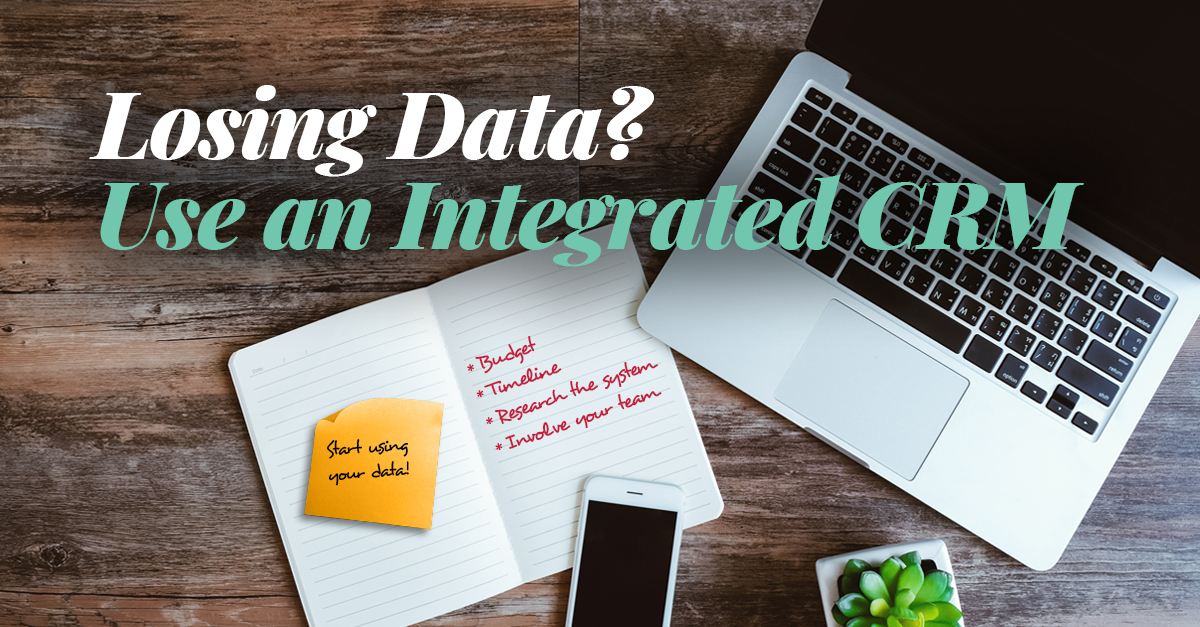Excel spreadsheets, handwritten notes, emailing yourself details about a customer’s preferences . . . all of these are ways that we input and track information about our leads, prospects and customers. Then there’s the encyclopedic knowledge you or your team members have stored in your heads that no one else has access to. But what happens if you or a point of contact in your company gets hit by the proverbial bus?
Why use a CRM?
When you lack a formal system for tracking your customer data, such as a Customer Relationship Manager (CRM) program, you lose data points. When you integrate a CRM into your email, marketing, sales and customer service, you accumulate data points that can give you insights that help you and your team close a deal.
50% of businesses aren’t using a CRM to grow their business, even though the numbers show that they contribute to sales growth by as much as 29%.
When your company uses a CRM correctly, anyone should be able to see where a customer or lead is in the process, at any point in time, including prior purchases and potentially online behavior. That allows others in your company to serve that person as well as anyone else. Simply, a CRM is not a sales too, it’s a business tool. At de Novo, we work with the Hubspot CRM platform, because we find it is the best tool for integrating your CRM into the center of your technology.
Implementing a CRM can be a big undertaking, and once upon a time, they were only for big companies with big budgets. Multiple companies offer a variety of systems now that can meet nearly every budget. They use simple interfaces that allow you to track customer interactions and information points, and they fully integrate with your website/marketing, Point of Sale, inventory systems and shipping.
Getting over internal resistance
Like any new system, it’s hard to bring in a new process when there’s a perception that the old process works just fine. But let’s be clear: complacency isn’t your friend, nor is it a forward-thinking approach. Complacency won’t take you to the next level. But there ARE ways to make this a lot easier.
When you are considering implementing a CRM system, here is a list of things to consider:
- Budget: It’s not just the monthly subscription or software fees, but the implementation costs, the cost of training staff, and potentially, some unforeseen IT costs to make sure the system works with your other systems, or that you can import existing data into the program. Also consider the savings of not needing or using other programs. Look for a CRM that replaces at least a few of your processes and collapses them into one. This is a good time for a platform audit that can help you collapse multiple systems into one.
- Timeline: Adopting a new system takes time. In moving to a new all-encompassing project management system at de Novo, we were told to “give it a year.” When someone tells you that—listen. It may take that long. Remind yourself and your team of this throughout the transition. Almost every (good) program is going to take a lot of work to become fully integrated. Make sure you plan and allot for the timeline.
- Research the system: Talk to others in your industry and beyond about what they use and read reviews on G2 Crowd and other objective sites. Your goal is to collect better data and be able to access and gain actionable insights.
- Involve your team: Buy-in works better when people feel heard, from admins to stakeholders. Listen to their concerns. Find out what the current pain points are and how a CRM like Hubspot solves them and will help the company meet its goals. Run internal demos, and once you decide on a system, bring the whole team up to speed on the process, the training timeline and the end goal, and enlist their support. Build in milestones and celebrations around launch and adoption of the new software. Listen when they express their frustration, but be firm in the expectations around use of the program.
Start using your data
In today’s world, there’s really no reason to not use a CRM at some level. Products range from free (or nearly free) to large enterprise level and industry specific programs. They can work with your production systems, and they can also provide a full marketing platform to track and report on all your various touch points with prospects, leads and customers. Start with your company goals in mind and thoroughly research your options, so you can start collecting and using the data you already own.
Like our post? Keep going down the rabbit hole with these similar reads:
The In-house Marketing vs. Agency Model: A Story of Collaboration – In-house marketing teams know their stuff—but sometimes they need outside inspiration to bring new ideas to the table. Learn how to freshen up your campaigns and keep your brand from going stale by embracing collaboration.
Barriers to Entry: Shedding Light on the Things That Hold Your Business Back – Tired of stagnating sales and slow growth? It’s time to step back and take an honest look at how your customers perceive and interact with your business.


